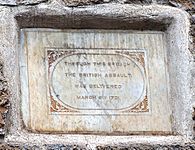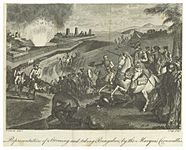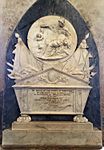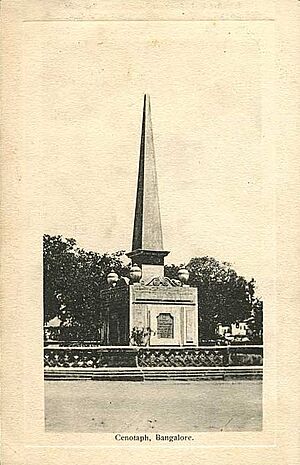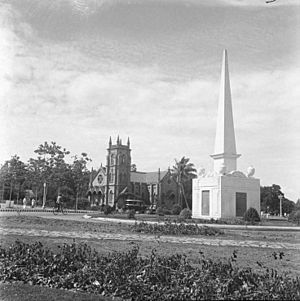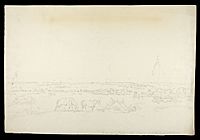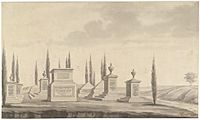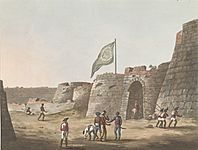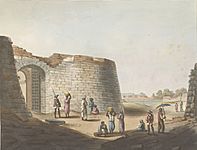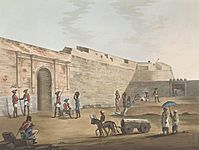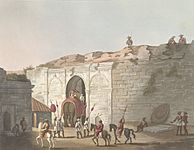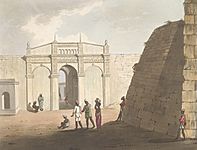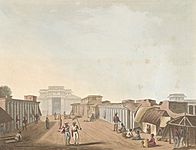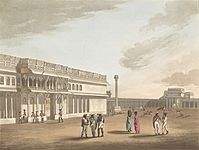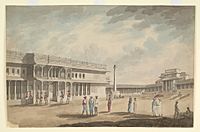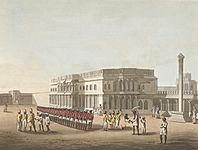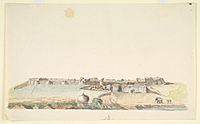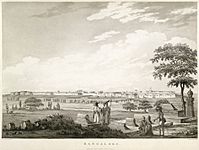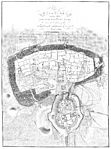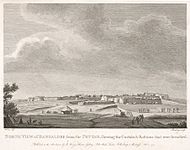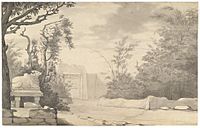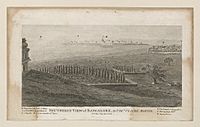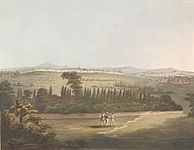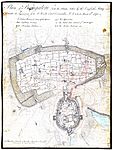Siege of Bangalore facts for kids
Quick facts for kids Siege of Bangalore |
|||||||
|---|---|---|---|---|---|---|---|
| Part of the Third Anglo-Mysore War | |||||||
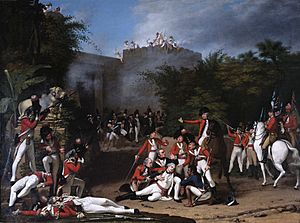 The Death of Colonel Moorhouse, Madras artillery, at the Storming of the Pettah Gate of Bangalore by Robert Home |
|||||||
|
|||||||
| Belligerents | |||||||
| Commanders and leaders | |||||||
The Siege of Bangalore was an important battle during the Third Anglo-Mysore War. It happened in 1791 in the city of Bangalore, which was then part of the Kingdom of Mysore. British forces, led by Charles Cornwallis, attacked the city's strong fort. Meanwhile, Tipu Sultan, the ruler of Mysore, tried to stop the British from outside the fort. The siege began on February 5, 1791, and ended with the British capturing the fort on March 21, 1791.
Contents
What Was Bangalore Like?
In 1791, Bangalore had two main parts: a strong fort and a "pettah." A pettah was a fortified town built just outside the main fort. This design was common in Indian cities. The fort was a safe place for people if the outer town was in danger.
The Fort's Defenses
The Bangalore Fort was about one mile around. It was made of solid stone and had a wide ditch around it. There were 26 towers along its walls, which helped defenders watch for enemies. The pettah was much larger, several miles around. It had weaker walls, a thick area of thorny plants, and a small ditch. Because of these defenses, Bangalore was a difficult place to attack.
The Siege Begins
The British army, led by Lord Cornwallis, arrived at Bangalore on February 5, 1791. They quickly captured the outer town (the pettah) on February 7. This was an important first step. However, Tipu Sultan's army was still nearby. He kept his forces close, hoping to attack the British while they were busy with the siege.
Attacking the Fort Walls
For the next twelve days, British engineers worked hard. They dug trenches and built places for their cannons. These cannons were used to create a hole, or "breach," in the fort's walls. Captain Kyd of the Bengal Engineers successfully made a breach using mortars.
The Final Attack
Lord Cornwallis decided to launch a surprise attack on the night of March 21, 1791. The Madras Pioneers, a group of skilled soldiers, led the way. They used ladders to cross the ditch and climb through the hole in the wall. They entered the fort first, while British cannons fired blank shots to distract the defenders. Once the breach was secure, the main British forces rushed in. A fierce hand-to-hand fight took place inside the fort. About a thousand of Tipu Sultan's soldiers were killed. The British captured the fort, securing their position against Tipu Sultan.
The Madras Pioneers later made Bangalore their permanent home.
- Siege of Bangalore, 1791
After the Battle
The British writer Mark Wilks noted that Tipu's soldiers fought bravely. However, their resistance lasted only a few hours before the fort fell. Losing Bangalore Fort greatly lowered the spirits of Tipu Sultan's army.
The British only held Bangalore Fort for one year. It was given back to Tipu Sultan after his defeat in 1792 and the signing of the Treaty of Seringapatam. However, after Tipu Sultan's final defeat in 1799, Bangalore Fort came under British control again. British soldiers stayed at the fort until 1888, when it was given to local authorities. Today, only a plaque marks the spot where the British broke through the walls. It reads: "Through this breach the British assault was delivered. 21 March 1791."
Remembering the Fallen
Many soldiers died during the Siege of Bangalore. Some were buried in a cemetery near the Fort Church. This cemetery was shown in a book by Robert Home, published in 1794. It contained the graves of several British officers. The cemetery was well-maintained, with cypress trees and flowers.
The Demolished Memorial
By 1912, the cemetery no longer existed. The names of the fallen soldiers were moved to a tall pillar called a cenotaph. This 35-foot-tall memorial honored those who died in the siege. It stood near the present-day Corporation Building and Hudson Memorial Church.
However, in 1964, local activists protested and demanded the cenotaph be removed. As a result, the Bangalore City Corporation tore down the memorial on October 28, 1964. The engraved stones were destroyed, and nothing remains of it today. A small piece of the cenotaph is now used as a bench in the Corporation Office. Many historians and people who love Bangalore's history are upset about this destruction.
Art and History
The Siege of Bangalore inspired many artists to create sketches and paintings. Artists like James Hunter, Thomas Daniell, William Daniell, and Robert Home captured scenes from the battle and the surrounding area. These artworks give us a detailed look at Bangalore and its fort during that time.
James Hunter's Sketches
James Hunter was a British military painter. He served as a lieutenant in the Royal Artillery. His sketches showed military life and everyday scenes in India. Hunter took part in the campaigns against Tipu Sultan.
Hunter drew many landscapes of South India, including Bangalore, Mysore, and Madras. His paintings were published in books like 'A Brief history of ancient and modern India' (1802–05) and 'Picturesque scenery in the Kingdom of Mysore' (1804). Hunter died in India in 1792.
- Bangalore Fort by James Hunter
- Tipu Sultan's Summer Palace in Bangalore Fort by James Hunter
Other British Sketches of Bangalore Fort


